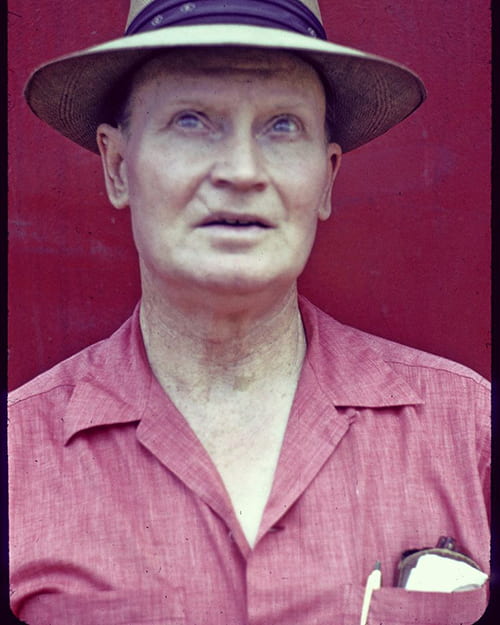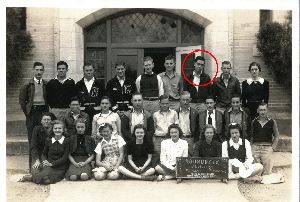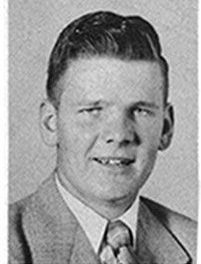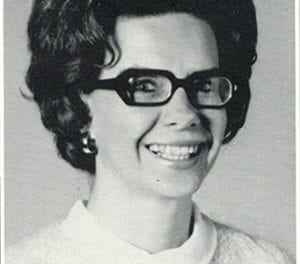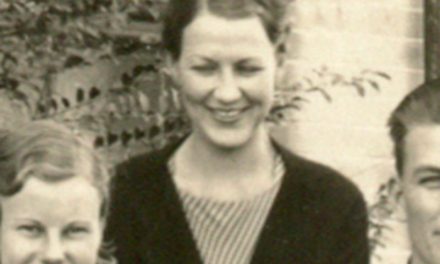One of the most famous persons to graduate from Rock Rock Schools was Vander Clyde Broadway, a gender fluid trapeze artist whose aerial acts thrilled crowds at the Moulin Rouge and all over Europe during the 1920s and 1930s. Known by his stage name “Barbette,” he was considered one of the greatest artists of that period.
Vander Clyde Broadway was born on December 19, 1899 in Trickham, Texas. After the death of his father, his mother, Hattie Wilson Broadway married Samuel Edward Loving of Round Rock. Together, they had six children, including artist Eugene Loving, known for his sketches and watercolors of New Orleans architecture and Staff Sergeant John M. Loving, a recipient of the Prisoner of War Medal.
Most residents of Round Rock were unaware of the talents of the man whose trapeze and aerial acts thrilled admiring crowds throughout the world.
Vander grew up on Anderson Avenue east of Mays Street – an area of Round Rock known as the “Flats” near a former cotton gin where his stepfather worked. Vander was known to staged shows in his backyard for the neighborhood children and adults by wire-walking on his mother’s clothes line. According to local folklore, Vander also practiced on the steel bridge over Brushy Creek near The Round Rock.
It was a trip to Austin to see a traveling circus performance that changed the course of his life. Vander was so enthralled by the performance and the lure of the circus that he wanted to join right away, but his parents wanted him to complete high school first. Determined to join the circus, Vander set out to complete his studies at Round Rock High School as quickly as he could and worked nearby cotton fields to earn money for his travel. Vander graduated at the age of 14 as the Valedictorian of the Round Rock High School Class of 1913. (Note: high school in Round Rock only went to grade 10 at the time.* Vander attended the Round Rock High School through the Round Rock Institute, which was incorporated into Round Rock ISD May, 1913.)
Shortly after he graduated Vander responded to an ad in Billboard Magazine placed by the “World Famous Aerial Queens,” a group known as the “Alfaretta Sisters.” One of the sisters had recently died and the act was desperately looking for a replacement. Auditions were held in San Antonio. The job came with the requirement that the new aerialist had to perform as a woman. It was with the Alfaretta Sisters where Vander both learned and perfected his act.
He next joined the trio act of “Erford’s Whirling Sensations.” As a member of this troupe, Vander again dressed as a woman and spun high above the big top suspended only by his teeth. The huge butterfly wings which were part of his costume floated in the air, creating the illusion of a giant insect in flight. Sensation, glamour, and disguise were an integral part of his performances.¹
In 1919, he launched his solo career dressed in drag as “Barbette” in New York City at the Harlem Opera House.
In 1923 Vander took to the stage of the Folies Bergère, a cabaret music hall located in Paris dressed in full drag as Barbette. During the show Barbette performed incredible acrobatic stunts such as walking a high wire and dangerous trapeze-related tricks. Vander’s appearance was so convincing that it left people to ponder the ambiguous performer’s true sexual identity. Members of the French avant-garde community were captivated by Clyde’s portrayal of Barbette including one of France’s most influential creative minds the great Jean Cocteau. Cocteau was so taken with Barbette that he commissioned surrealist photographer Man Ray to take a series of photographs showing Vander’s metamorphosis into the ethereal, androgynous Barbette.
While most aerialists of the day performed tricks, Barbette’s act was more theatrical. He would perform on the tightrope and trapeze in full drag, then pull off his wig and strike exaggerated manly poses. The provocative act made him the toast of the Parisian avant-garde; Jean Cocteau wrote that “I myself have seen no comparable display of artistry on the stage since Nijinsky.” Cocteau later wrote an influential essay on the nature and artifice of theater called Le Numero Barbette, which was illustrated with images of Barbette getting into costume taken by surrealist photographer Man Ray.³
For his charade, “Barbette, the Enigma” received as much as $2,000 per performance. He became the toast of Parisian society, and was befriended by European nobility and the literary set. In Paris, he performed at the Moulin Rouge and the Cirque Needrano, in London at the Mills’ Olympia, the Circo de Prince in Madrid, the Circus Schumann in Copenhagen, and the Cirque Royal in Brussels. Even though he performed throughout the world, he love dto return to his adopted home of Paris.
Broadway was portrayed as a female Parisian socialite in the film “Blood of a Poet,” written by the avant-garde writer, Jean Cocteau.
In 1938, Barbette became ill while performing at the Loew’s State Theatre in New York. He collapsed and was was rushed to the hospital and was later diagnosed with polio. His days of performing were over.
He returned to the profession in 1942 as a mentor. For many years he was the aerial director for the Ringling Brothers, Barnum and Bailey Circus and later worked for numerous circuses, instruction and direction aerial performances. He staged the Japanese Circus finale in Orson Welles’s movie, “Around the World” in 1946 and was a consultant to MGM Studios during the filming of “Jumbo”.² He was hired to coach Jack Lemmon and Tony Curtis on gender illusion for the 1959 film Some Like It Hot.
In 1963 he returned to Texas to live with his sister Mary Cahill in Round Rock. His health was failing, but he continued to work with the Shriner Circus and the touring show, “Disney on Parade” and would choreograph acts and design costumes for the next season.
Barbette was cremated and laid to rest at the foot of his mother’s grave in the Round Rock Cemetery. The marker simply reads, “Barbette December 19, 1899- August 5, 1973,” The Texas Historical Commission has recently approved an historic marker about Barbette, to be placed at his gravesite in Round Rock Cemetery.
Barbette was named a Local Legend by the City of Round Rock in 2015.
* Vander attended the Round Rock Institute, which was incorporated into the newly established Round Rock ISD during the time of his graduation).
¹ Source: “Historical Round Rock” (book) by Jane H. DiGesualdo & Karen R. Thompson.
² Source: “Historical Round Rock” (book) by Jane H. DiGesualdo & Karen R. Thompson
³ Source: City of Round Rock website – Local Legends
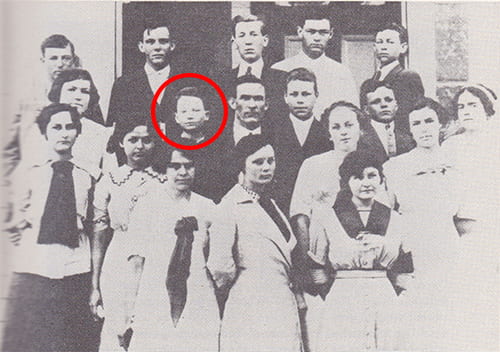
Round Rock HS Class of 1913. Vander Clyde Broadway circled in red. Image available on the Internet and included in accordance with Title 17 U.S.C. Section 107.
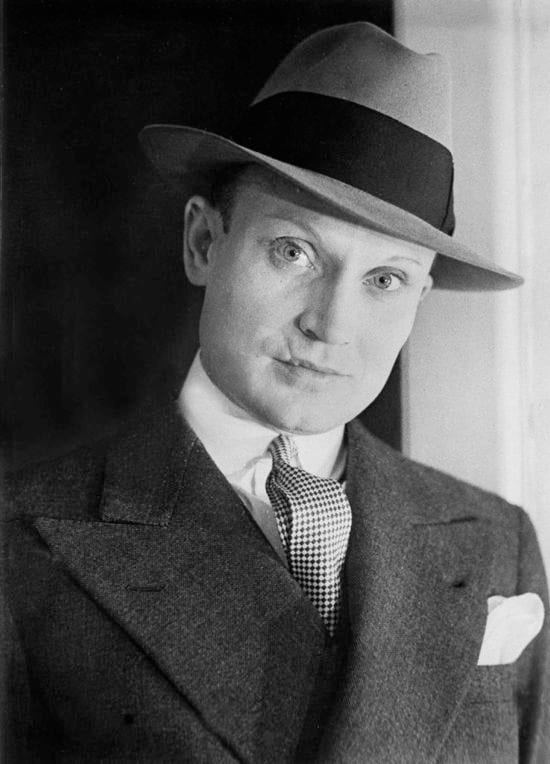
Vander Clyde Broadway “Barbette.” Image available on the Internet and included in accordance with Title 17 U.S.C. Section 107.

Barbette. Image available on the Internet and included in accordance with Title 17 U.S.C. Section 107.



